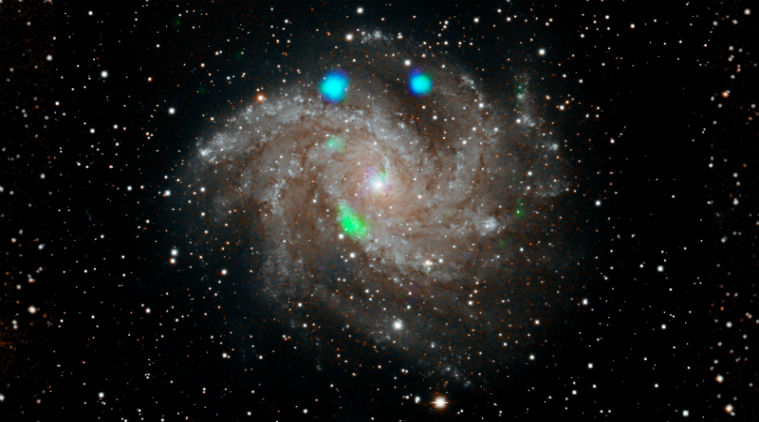
NASA’s NuSTAR space observatory has captured extremely bright sources of X-ray light that appeared as bright blue and green spots. However, these colourful blobs disappeared days later.
One of the latest study, which was recently published in Astrophysical Journal, offers some probable explanations for the appearance of a green blob near the galaxy’s center, which showed up and disappeared within weeks.
The primary goal of the NuSTAR observations was to look at the supernova – explosion of a huge star. The green blob, which is known as ultraluminous X-ray source (ULX), near the bottom of the galaxy did not feature during the first observation. However, it appeared during a second observation after 10 days. Another NASA telescope called Chandra X-ray Observatory took a look at it again and found the object that had quickly disappeared. This object has been named as ULX-4 because it is the fourth ULX identified in this galaxy.
“Ten days is a really short amount of time for such a bright object to appear,” Hannah Earnshaw, a postdoctoral researcher at Caltech in Pasadena, California and lead author on the new study, said in a statement. “Usually with NuSTAR, we observe more gradual changes over time, and we don’t often observe a source multiple times in quick succession. In this instance, we were fortunate to catch a source changing extremely quickly, which is very exciting.”
According to the study, it can be possible that the light was from a black hole consuming another object like a star. When an object gets too close to a black hole, it can get pulled apart by gravity, and the debris gets pulled into a close orbit around the black hole. The material at the disk’s inner edge starts moving so quickly that it gets heated up to millions of degrees and radiates X-rays, NASA explained. For comparison, the surface of the Sun is around 10,000 degrees Fahrenheit or 5,500 degrees Celsius.
Most ULXs typically last longer because they are formed by dense objects like black holes that “feed” on a star for an extended time. Short-lived or transient X-ray sources like this particular ULX are not common, so its appearance could be explained by a scenario such as a black hole quickly destroying a small star.
However, this ULX may not be a single event, The study’s authors suggest that its source may be a neutron star- which is an extremely dense object created from the explosion of a star that wasn’t big enough to create a black hole. Like black holes, neutron stars can pull in material and cause debris to move really fast in a disk.
Neutron stars can generate such strong magnetic fields which make “columns” that channel material down to the surface. These generate powerful X-rays in the process. But if the neutron star spins especially fast, material cannot reach the surface and create these X-ray bursts.
Also Read | Scientists ponder over discovery of ‘physically impossible’ black hole
“This result is a step towards understanding some of the rarer and more extreme cases in which matter accretes onto black holes or neutron stars,” Earnshaw said in the statement.